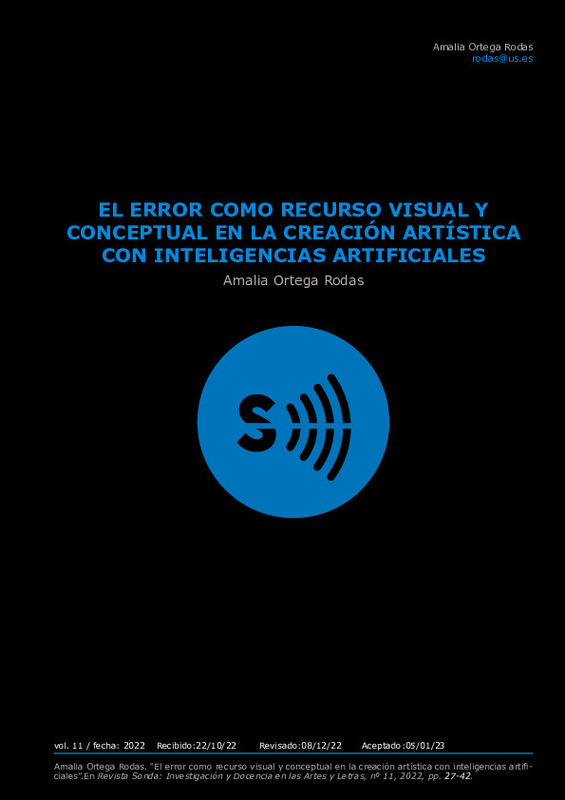Achón-Lezaun, I. (2020). Lo siniestro: más allá de Freud. Tropelías. Revista de Teoría de la Literatura y Literatura Comparada, 34, 1-7. https://doi.org/10.26754/ojs_tropelias/tropelias.2020344573
Basogain, X., Olabe, M., Espinosa, K., Rouèche, C. y Olabe, J.C. (2007). Realidad Aumentada en la Educación: una tecnología emergente. Online Educa Madrid 2007: 7ª Conferencia Internacional de la Educación y la Formación basada en las Tecnologías (24-29).
Belting, H. (2007). Antropología de la imagen. Katz Editores. https://doi.org/10.2307/j.ctvm7bcgx
[+]
Achón-Lezaun, I. (2020). Lo siniestro: más allá de Freud. Tropelías. Revista de Teoría de la Literatura y Literatura Comparada, 34, 1-7. https://doi.org/10.26754/ojs_tropelias/tropelias.2020344573
Basogain, X., Olabe, M., Espinosa, K., Rouèche, C. y Olabe, J.C. (2007). Realidad Aumentada en la Educación: una tecnología emergente. Online Educa Madrid 2007: 7ª Conferencia Internacional de la Educación y la Formación basada en las Tecnologías (24-29).
Belting, H. (2007). Antropología de la imagen. Katz Editores. https://doi.org/10.2307/j.ctvm7bcgx
Benney, M. & Kistler, P. (2021). AIArtists.org. https://aiartists.org.
Broad, T., Fol Leymarie, F. & Grierson, M. (2020). Amplifying The Uncanny. 8th Conference on Computation, Communication, Aesthetics & X (xCoAx 2020), pp. (33-42).
Cetinic, E. & She, J. (2022). Understanding and Creating Art with AI: Review and Outlook. ACM Transactions on Multimedia Computing, Communications, and Applications. 18 (2), article nº 66, 1-22. https://doi.org/10.1145/3475799
Chapman, L. (1967). Illusory correlation in observational report. Journal of Verbal Learning and Verbal Behavior, 6 (1), 151-155. https://doi.org/10.1016/S0022-5371(67)80066-5
Figueras-Ferrer, E. (2021). Reflexiones en torno a la cultura digital contemporánea. Retos futuros en educación superior. Arte, Individuo y Sociedad 33(2), 449-466. https://doi.org/10.5209/aris.68505
Fontcuberta, J. (2016). La furia de las imágenes. Notas sobre la postfotografía. Galaxia Gutemberg
Forbes, A.G. (2020). Creative AI: From Expressive Mimicry to Critical Inquiry. In: Burbano, A. & West, R. (coord.), AI, Arts & Design: Questioning Learning Machines. Artnodes, 26, 1-10. https://doi.org/10.7238/a.v0i26.3370
García-Sedano, M. (2015). Una revisión del concepto de postfotografía. Imágenes contra el poder desde la red. Liño 21. Revista Anual de Historia del Arte, 125-132. https://doi.org/10.17811/li.21.2015.125-132
Gil Segovia, J. (2020). Desmitificando la posfotografía: de la muerte de la fotografía al nacimiento de varias fotografías. Revista Sonda. Investigación en Artes y Letras, 9, 27-42. https://doi.org/10.4995/sonda.2020.17851
Godoy-Contreras, I. (2017). De las estéticas del horror a las figuras de lo infame. Revista Co-herencia, 14 (26), 59-86.
https://doi.org/10.17230/co-herencia.14.26.3
Goh, G., Ramesh, A., Pavlov, M. and Gray, S.(2021). DALL·E: Creating Images from Text. Recuperado el 28 de mayo de 2022, de https://openai.com/blog/dall-e/
Goodfellow, I., Pouget-Abadie, J., Mirza, M., Xu, B., Warde-Farley, D., Ozair, S., Courville, A. & Bengio, Y. (2020). Generative Adversarial Nets. Communications of the ACM, 63 (11), 139-144. https://doi.org/10.1145/3422622
Grba, D. (2022). Deep Else: A Critical Framework for AI Art. Digital, 2, 1-32. https://doi.org/10.3390/digital2010001
Hertzmann, A. (2018). Can Computers Create Art?. Arts 2018, 7(2), 18. https://doi.org/10.3390/arts7020018
Hertzmann, A. (2019). Aesthetics of Neural Network Art. arXiv:1903.05696. https://doi.org/10.48550/arxiv.1903.05696,
Hertzmann, A. (2020). Computers do not make art, people do. Communications of the ACM, 63 (5), 45-48. https://doi.org/10.1145/3347092
Manovich, L. (1995). The paradoxes of digital photography. En: Photography After Photography. Exhibition Catalog, Verlag der Kunst, Munich, 1-20.
Molesworth, H. (2003). From Dada to Neo-Dada and Back Again. October, 105, 177-181. https://doi.org/10.1162/016228703769684272
Mordvintsev, A., Tyka, M., & Olah, C. (2015). Inceptionism: Going deeper into neural networks. Google Research Blog, 1-8. https://research.googleblog.com/2015/06/inceptionism-going-deeper-into-neural.html
Mori, M. (1970). The uncanny valley. Energy, 7(4), 33-35.
Ortega, N. (2020), Inteligencia Artificial y campo del arte, Paradigma.Revista Universitaria de Cultura, 32-50.
Paglen, T. & Crawford, K. (2019). Excavating AI. https://www.excavating.ai.
Vlad, C. A. (2009). Dadá: Bucarest, Zúrich, París. Una Historia Del Dadaísmo. Quintana. Revista de Estudos do Departamento de Historia da Arte (8), 271-279.
[-]








